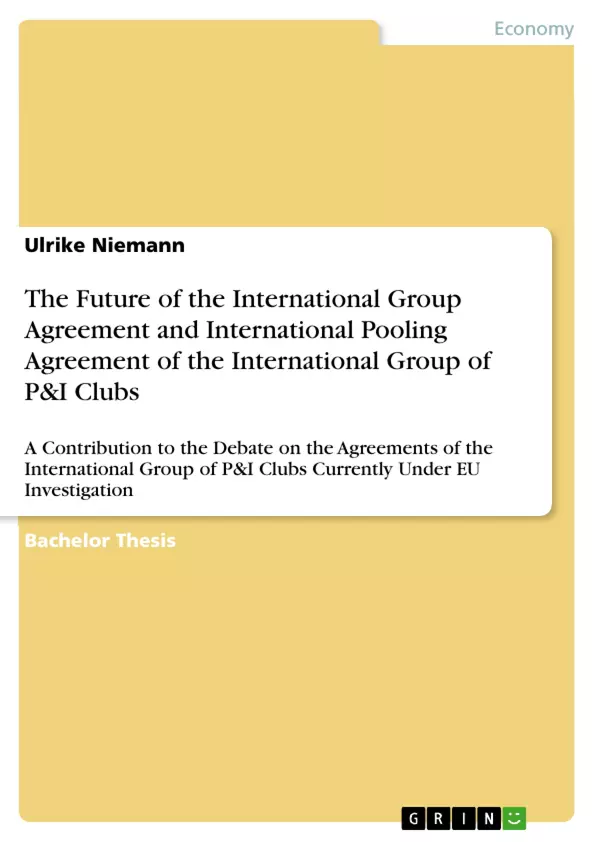The following striking news was announced on 26 August 2010 in Brussels on the billboard of the involved parties:
“Antitrust: Commission opens formal probe into marine insurance agreements” (Commission 2010a, IP/10/1079: 1-2).
From that day on publication no. IP/10/1072 became a well-known EU paper among marine insurance market participants. It has influenced its daily operation, although this is not necessarily obvious, since it is still considered a rather sensitive topic and is thus hidden from any further publicity.
After having announced this, the European Commission has made good on its word and started an investigation process of which the following extract lays the foundation:
The thirteen largest clubs of non-governmental mutual marine insurance societies, the Protection & Indemnity clubs (P&I clubs), are members of the International Group of P&I clubs. Currently they insure third-party liabilities to more than 90% of the world sea-going tonnage, around 95% of the ocean-going tankers and about 60% in terms of the amount of world-wide trading vessels. These clubs are covered by an agreement of mutuality, the International Group Agreement (IGA). They are bound by its particular guidelines on claims-sharing and joint reinsurance with the intention of preventing other member clubs from undercutting each other’s price rates in case of a ship owner switching from its insuring club (holding club) to another club (new club) within the Group membership.
The EU commission claims some of the regulations of the International Group of P&I Clubs are questionable in terms of the competition among the member P&I clubs as well as the entry barriers for non-member clubs to the relevant markets.
Inhaltsverzeichnis (Table of Contents)
- Introduction
- Background of the topic
- Marine insurance sectors
- Marine insurance market
- Global marine insurance market
- Protection & Indemnity insurance market
- Statement of the problem
- Objective of the thesis
- Structure of the thesis
- Background of the topic
- Theoretical fundamentals
- Introduction to the International Group of P&I Clubs
- The unique mutual insurance system of marine Protection & Indemnity clubs
- Historical development of the Protection & Indemnity insurance
- Background on the International Group of P&I Clubs
- Organisation and structure
- Functions and objectives
- The International Group Pooling Agreement
- The International Group Agreement
- Introduction to the International Group of P&I Clubs
- Discussion of controversy
- The strengths of the International Group of P&I Clubs' agreements
- The weaknesses of the International Group of P&I Clubs' agreements
- Conclusion of discussion of controversy
- Future scenario
- The most probable outcome of the EU competition authority investigation
- Abstract on aviation and nuclear insurance markets
- Conclusion and forecast
Zielsetzung und Themenschwerpunkte (Objectives and Key Themes)
This thesis examines the future of the International Group Agreement and International Pooling Agreement of the International Group of P&I Clubs, specifically within the context of the ongoing EU investigation into their agreements. The work aims to provide an in-depth analysis of the current state of the P&I club system and to explore potential consequences of the EU investigation. Key themes explored within the thesis include:- The historical development and current structure of the International Group of P&I Clubs.
- The unique mutual insurance system employed by these clubs.
- The strengths and weaknesses of the International Group Agreement and International Pooling Agreement.
- Potential implications of the EU investigation into the agreements of the International Group of P&I Clubs.
- Future scenarios for the International Group of P&I Clubs in light of the EU investigation.
Zusammenfassung der Kapitel (Chapter Summaries)
- **Introduction:** The first chapter introduces the background of the topic, focusing on the marine insurance sectors and the global and Protection & Indemnity (P&I) insurance markets. The chapter concludes with a statement of the problem, the objective of the thesis, and its structure.
- **Theoretical fundamentals:** This chapter dives into the International Group of P&I Clubs, covering their unique mutual insurance system, their historical development, and their organization and structure. The International Group Pooling Agreement and International Group Agreement are also discussed in detail.
- **Discussion of controversy:** The third chapter delves into the strengths and weaknesses of the International Group of P&I Clubs' agreements, prompting a discussion of potential controversies.
- **Future scenario:** This chapter explores the possible outcome of the EU competition authority investigation and presents an abstract on the aviation and nuclear insurance markets for comparative analysis.
Schlüsselwörter (Keywords)
This thesis explores the International Group of P&I Clubs, their unique mutual insurance system, and the EU investigation into their agreements. The key terms and concepts of the work include marine insurance, Protection & Indemnity (P&I) insurance, International Group Agreement, International Pooling Agreement, mutual insurance, EU competition law, and future scenarios.- Citation du texte
- Ulrike Niemann (Auteur), 2011, The Future of the International Group Agreement and International Pooling Agreement of the International Group of P&I Clubs, Munich, GRIN Verlag, https://www.grin.com/document/203358



